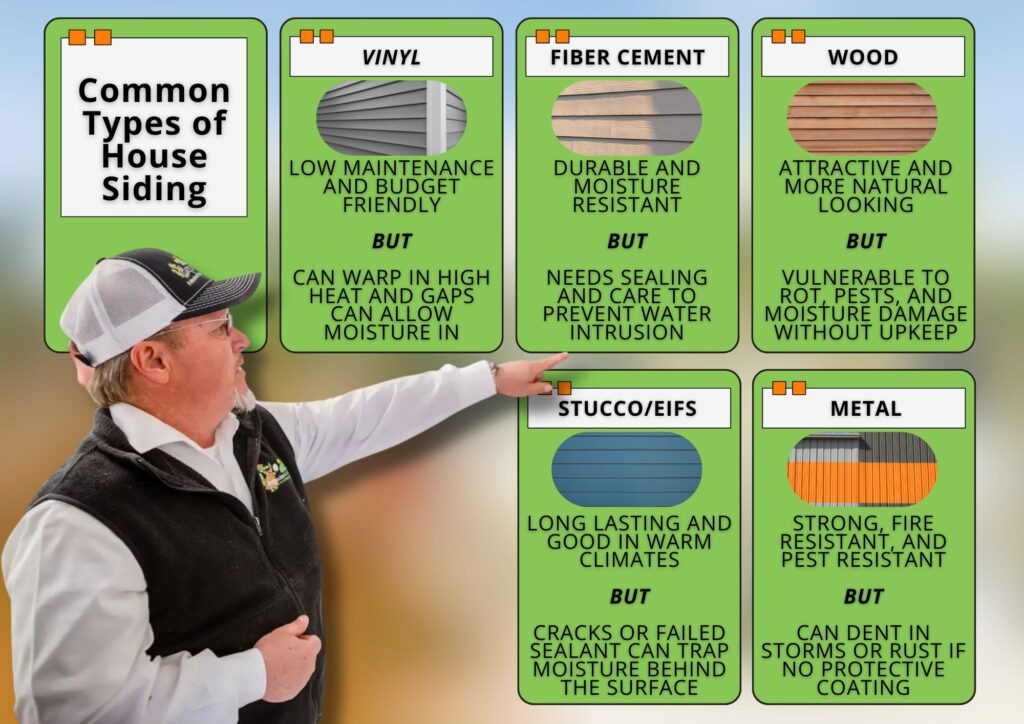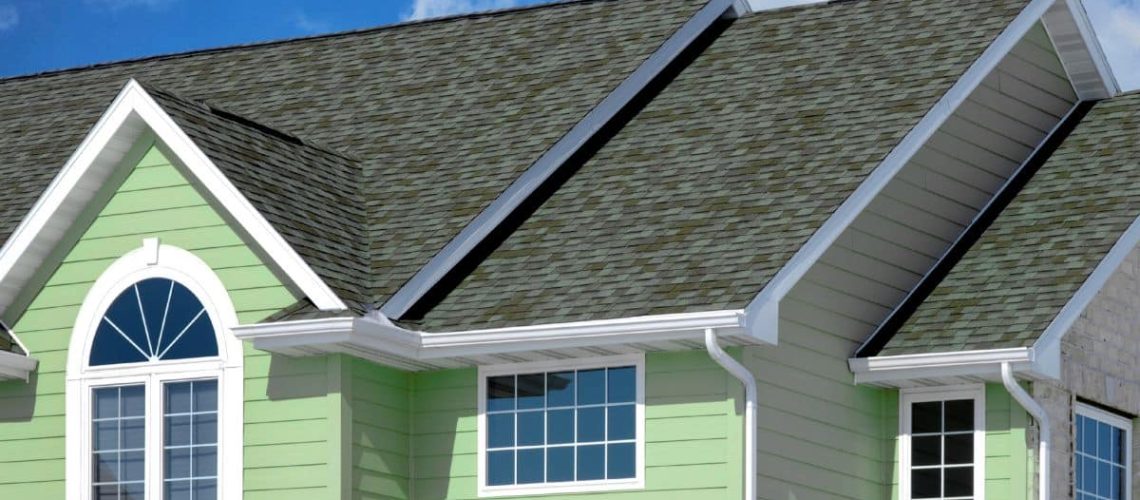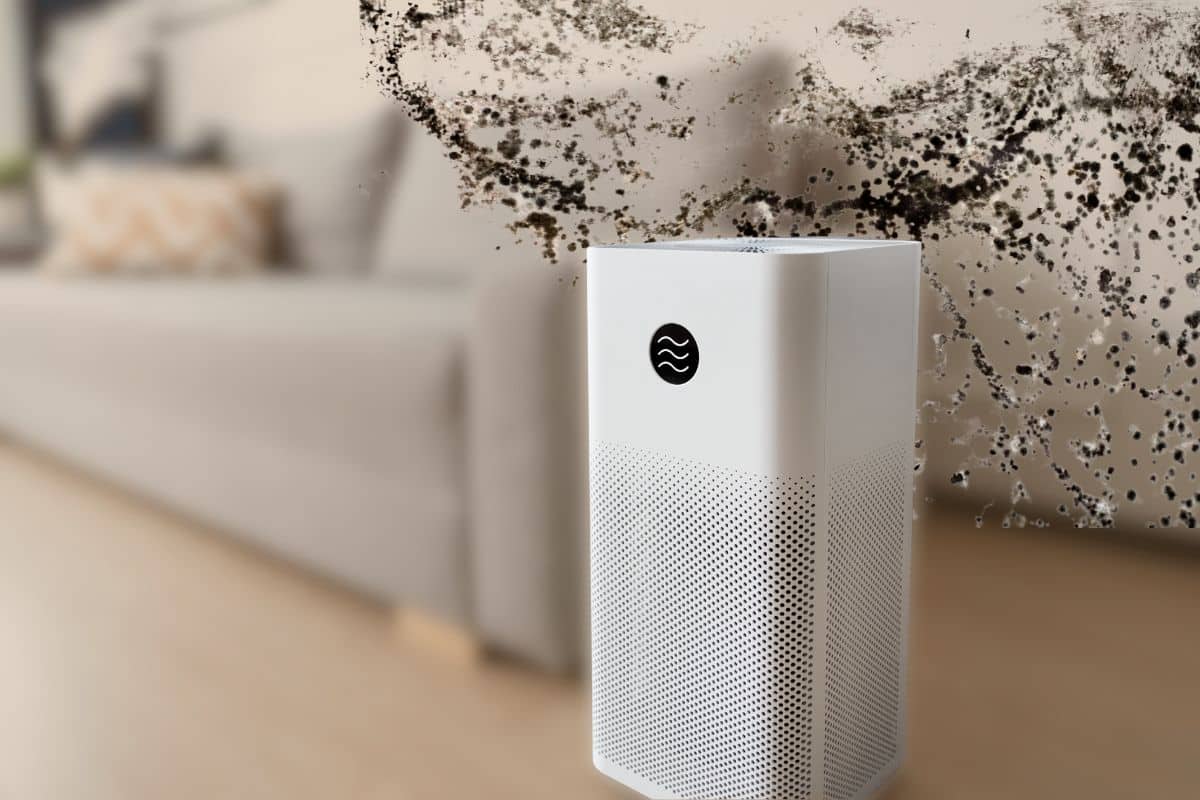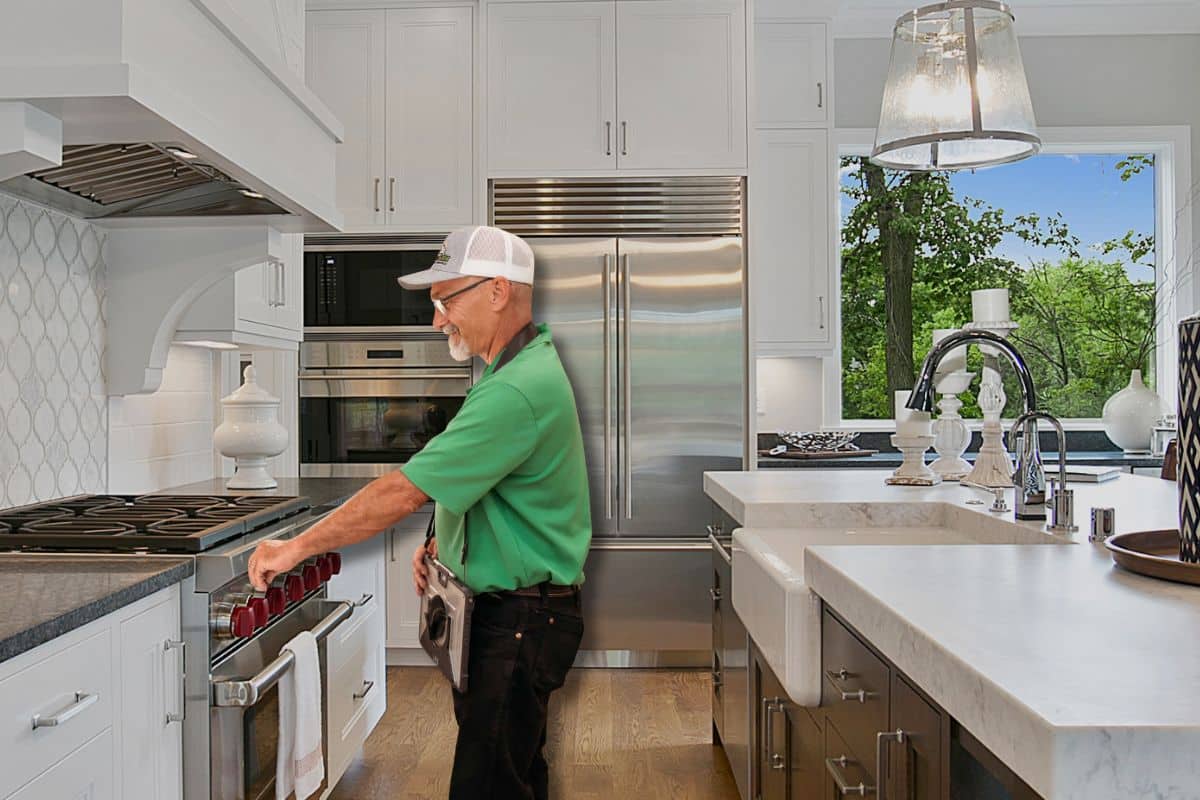Below is a clear guide to five common siding types, how they hold up here, and the warning signs inspectors watch closely.
Siding takes the brunt of heat, moisture, wind, and daily wear. In certain regions and climates, those stresses are even greater.
Hot summers, heavy rain, sudden storms, and high humidity all affect how long siding lasts and how often problems appear during a home inspection. When siding begins to fail, moisture can find its way into the wall structure, which is one of the biggest concerns inspectors look for in this region.
Whether you are buying a home or maintaining one you already own, knowing how siding behaves in your local climate helps you understand inspection findings and take action before small problems grow.
Table of Contents
ToggleHow Siding Impacts a Home Inspection
Siding types vary in more than just surface material. It plays a major role in moisture control, energy efficiency, pest resistance, and the long-term health of the home. During an inspection, the siding type often determines which issues are most likely.
Moisture is the biggest risk in this region. NOAA weather data shows that Texas and Arkansas consistently experience high humidity levels throughout the year.
When humidity combines with heat, siding materials expand more.
When storms arrive, strong winds push water against the exterior. If gaps, cracks, or worn areas exist, water can slip behind the siding and create hidden damage.
Inspectors look for these moisture entry points along seams, trim edges, fasteners, and at the bottom of walls. They also review how siding interacts with gutters, grading, and roof runoff.
With this foundation in mind, the next sections break down how each siding type performs.

1. Vinyl Siding
Vinyl siding is one of the most widely used siding materials in the United States. The U.S. Census Bureau reports that vinyl accounts for more than a quarter of new home siding installs nationwide. In the markets Inspection Gator serves, vinyl is especially common on homes built after the mid-1990s.
How It Performs in This Region
Vinyl handles moisture well but does not handle heat as effectively. Long periods of intense sunlight can cause it to soften. Once softened, the panels can warp or ripple. This is a common issue in Northeast Texas and Southeast Oklahoma during peak summer months.
The U.S. Department of Energy confirms that vinyl’s surface temperature can rise dramatically when exposed to sunlight, especially when nearby windows reflect heat onto certain areas.
Vinyl also moves with temperature changes. Rapid morning heat followed by afternoon storms can cause the panels to expand and contract quickly.
Over time, this movement can create small gaps at the ends of panels or at trim intersections. If those gaps widen, water can reach the sheathing underneath.
Storms are another challenge. Winds from severe thunderstorms can lift loose vinyl panels or push water under an already weakened section.
What Inspectors Look For
- Warped, bowed, or wavy panels
- Cracks caused by heat stress or impact
- Loose or lifted sections
- Gaps around windows, doors, and corners
- Water stains that signal moisture behind the surface
Inspectors also check the bottom edge of vinyl panels. If the siding sits too close to the ground, moisture can wick upward and soften the sheathing.
2. Fiber Cement Siding
Fiber cement siding is one of the strongest types for homes in warm, storm-prone areas. It mimics the look of wood but lasts significantly longer.
Many neighborhoods in Northeast Texas and Southwest Arkansas use fiber cement on newer builds for its durability.
How It Performs in This Region
Fiber cement is dense and stable. According to the Building Science Corporation, fiber cement resists swelling, rot, and insect activity far better than wood. This makes it well-suited for humid climates like those around Texarkana and Broken Bow.
However, proper installation matters. Joint sealing, fastener placement, and flashing details help protect the structure. If these steps are performed poorly, rainwater can seep behind the boards. Once moisture enters the cavity behind fiber cement, it can remain trapped for a long time.
Paint care is important as well. Although fiber cement does not rot, it can absorb water if paint or sealant wears thin. Many homes in this region have painted siding that faces intense sunlight, which causes faster paint breakdown on south and west-facing walls.
What Inspectors Look For
- Cracked boards
- Joint gaps that lack caulking
- Peeling paint or exposed edges
- Improper clearance above soil or hard surfaces
- Moisture stains on the lower courses
Inspectors often review these areas closely because small installation errors can lead to long-term water intrusion.
3. Wood Siding
Wood siding adds warmth and character, but it needs more care than other materials. Cedar, pine, and engineered wood products are found in older properties and rural homes throughout Northeast Texas and Southeast Oklahoma.
How It Performs in This Region
Wood absorbs moisture easily. The Environmental Protection Agency states that moisture is the primary cause of wood decay, and humid climates make the risk much higher.
When wood siding stays damp, it can swell or warp. If the protective stain or paint breaks down, water can reach deeper layers and spark rot.
Wood is also vulnerable to pests. Termites are common across Texas and Arkansas, and softwood is easier for them to enter. Homes with shaded exteriors or heavy tree coverage may see wood stay wet longer after storms, which increases the chance of decay.
Sun exposure also affects wood. Harsh afternoon sunlight on west-facing walls can dry out the surface too quickly and cause cracking.
What Inspectors Look For
- Soft, spongy, or crumbling boards
- Rot near the bottoms of walls
- Small holes or tunnels from insects
- Warping that opens gaps between boards
- Peeling paint or exposed raw wood
Inspectors also check the condition of trim boards around windows and doors, since these locations often show early signs of moisture problems.
4. Stucco Siding
Stucco is less common here than vinyl or fiber cement, but it appears on suburban homes and custom builds. Traditional stucco and synthetic stucco have different behaviors, and both require proper moisture control.
How It Performs in This Region
Traditional stucco can last many years when installed with good drainage and sealed regularly. The main challenge is cracking. As temperature shifts occur and the house settles, stucco can develop thin cracks that allow moisture to enter.
Synthetic stucco, also known as EIFS, has a different structure. It includes layers of foam and mesh beneath a synthetic finish. EIFS performs well when installed correctly, but it needs perfect sealing at every seam. If moisture slips behind the outer layer, it may not escape easily.
According to Building Science Corporation, up to 90% of EIFS failures involve moisture intrusion due to improper sealing or flashing.
Humidity plays a major role in how stucco ages in this region. Frequent rainstorms saturate the surface, and if cracks are present, water can reach the sheathing.
What Inspectors Look For
- Cracks near corners, windows, and doors
- Bulges or soft areas
- Staining that suggests trapped water
- Failed sealant around penetrations
- Poor drainage or grading at the base
Inspectors may pay extra attention to stucco homes because moisture issues can remain hidden for a long time.

5. Metal Siding
Metal siding types appear on rural homes, manufactured homes, workshops, and newer modern builds. Aluminum and steel are the most common materials.
How It Performs in This Region
Metal siding resists pests very well and handles heat better than vinyl or wood. It also expands less with temperature changes. However, metal is vulnerable to denting and corrosion.
The Insurance Institute for Business and Home Safety reports that hail is one of the most common sources of property damage in Texas and Oklahoma. Metal siding often shows dents after hailstorms, even when the damage does not affect the structure underneath. Over time, chipped coatings can expose metal to moisture and create rust.
Steel tends to rust more easily than aluminum, but aluminum can dent more easily. Both types should stay clear of soil contact so moisture does not reach the unprotected edges.
What Inspectors Look For
- Rust spots that signal coating failure
- Dents from hail or wind-blown debris
- Loose fasteners or separated seams
- Water staining along the bottom edge
- Paint loss that exposes bare metal
If metal siding is installed on a manufactured home, inspectors also review how panels meet at corners and around doors, since these areas can loosen over time.
Comparison of Siding Types for the Region
| Siding Type | Strengths | Weaknesses | Performance in This Region |
| Vinyl | Affordable, low upkeep | Warping, cracking | Moderate |
| Fiber Cement | Needs proper installation | Pest-resistant, strong | Strong |
| Wood | Attractive, natural | Rot, pests | Variable |
| Stucco | Durable when sealed | Moisture sensitive | Moderate |
| Metal | Pest resistant, strong | Dents, rust | Strong |
Related Questions Homeowners Ask
What siding problems raise the biggest concerns during a home inspection?
Issues like moisture intrusion, missing panels, rot, open seams, and failed caulking often indicate deeper structural concerns.
Which siding types last the longest in Northeast Texas?
Fiber cement and metal generally perform the best in high heat and storm-prone areas.
Can improper drainage affect the siding condition?
Yes. Poor grading, clogged gutters, or roof runoff can push water against the siding and foundation.
Do pests enter through damaged siding?
Yes. Any gaps can create openings for termites, carpenter ants, and rodents.
When to Call a Professional
If you notice cracked, warped, stained, or loose siding, it may be time for an inspection. These issues can allow moisture to reach the structure behind the walls. Even small defects can grow quickly in humid climates.
If you are buying a home in Northeast Texas, Southwest Arkansas, or Southeast Oklahoma, a full inspection provides clarity on siding condition and any hidden issues. For homeowners, periodic inspections help catch problems early and protect the home’s long-term value.
Inspection Gator provides detailed, clear home inspections and new construction inspections that help you understand the true condition of your siding and the rest of the home.
Conclusion
Different types of siding affect comfort, energy use, and the overall health of a home differently. Understanding how different materials behave in this region helps you make informed decisions and monitor signs of wear.
With the right information and a thorough home inspection, you can protect your investment and stay ahead of potential problems. Book your inspection today.





